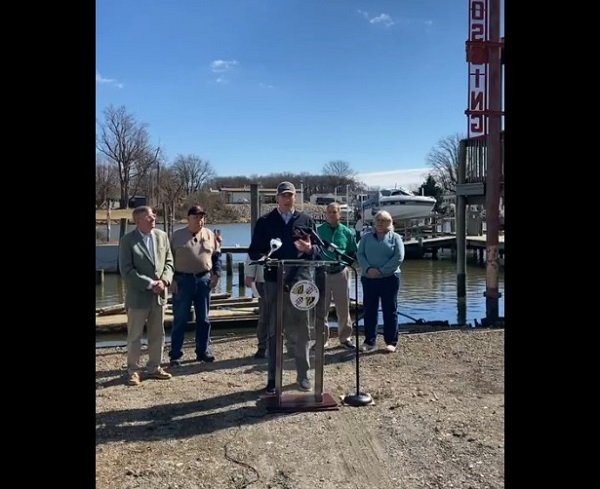TOWSON, MD—County Executive Johnny Olszewski on Thursday highlighted a short-duration Baltimore County project engaging local watermen to remove between 1,500 and 2,500 derelict crab pots and fishing gear from the bottom of the Chesapeake Bay, at the mouth of the Patapsco River off the North Point Peninsula.
“Bringing together the environmental science community and county government to work alongside our local watermen to clean up the Chesapeake Bay represents a real win-win project,” Olszewski said. “In removing thousands of derelict crab pots, we not only protect and improve the environment, but we do so in a way that also supports the watermen and small businesses who depend on the Bay for their livelihood.”
Baltimore County Department of Environmental Protection and Sustainability (EPS) provided a $125,000 grant to the Maryland nonprofit organization, Oyster Recovery Partnership (ORP), to manage this collaborative project by using side scan sonar technology to survey areas known to be heavily fished and crabbed, and hiring crews of watermen to remove and document the debris.
“When planning large scale oyster restoration, we often notice derelict fishing gear on side scan sonar mapping of the Chesapeake Bay’s bottom. We’re happy to leverage ORP’s expertise and join Baltimore County and Maryland watermen in addressing this problem,” said Ward Slacum, Executive Director, Oyster Recovery Partnership.
Addressing the Problem of “Ghost Pots” in the Bay
An estimated 3.3 million crabs are killed annually in the Chesapeake Bay by these derelict crab pots, or “ghost traps,” according to a 2016 study by the Virginia Institute of Marine Science. The mouth of the Patapsco is a naturally attractive habitat for blue crabs and is an important site for the local crabbing industry.
Derelict crab pots are typically lost during storms or accidentally cut loose by boat propellers. They remain on the bay bottom, continuing to trap crabs, finfish, turtles and other aquatic species. This competes with active commercial and recreational crabbing and fishing. This derelict gear directly harms the Chesapeake Bay ecology and commercial blue crab fishery by trapping and killing crabs, finfish, turtles and other aquatic species, effectively competing with active commercial and recreational crabbing and fishing by passively collecting and killing these same seafood resources.
ORP hired 13 crews of local watermen during their winter off-season for retrieval operations during the first two weeks of March. The goal is to remove about 50 to 70 percent of the more than 3,000 accumulated derelict traps that were identified using side scan sonar technology in late January and early February. Skilled watermen provide the needed expertise and techniques for the salvage operation.
The recovered crab pots and gear will be removed manually and either recycled or disposed, depending on their condition, by the Baltimore County Department of Public Works and Transportation.
Crews document the condition of every trap and report whether the traps and other gear contain trapped crabs, finfish or other contents. ORP will complete data analysis this spring and submit a final project report to EPS this summer.

